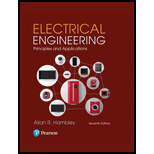
Electrical Engineering: Principles & Applications Plus Mastering Engineering with Pearson eText -- Access Card Package (7th Edition)
7th Edition
ISBN: 9780134712871
Author: Allan R. Hambley
Publisher: PEARSON
expand_more
expand_more
format_list_bulleted
Question
error_outline
This textbook solution is under construction.
Students have asked these similar questions
No chatgpt pls will upvote
NO AI PLEASE
NO AI PLEASE
Knowledge Booster
Learn more about
Need a deep-dive on the concept behind this application? Look no further. Learn more about this topic, electrical-engineering and related others by exploring similar questions and additional content below.Similar questions
- P5. Although all fuses possess a thermal element that melts resulting in an open circuit, describe the difference between an "expulsion" and a "current limiting" fuse.arrow_forwardExpert only, don't use Artificial intelligence or screen shot it solvingarrow_forwardSolve this. find the initial conditions ic(0-) and vc(0-) the switch opens at t=0 so it's closed at t=0- dont copy the response from previous because it's wrong. please solve in great detail explaining everything step by step. now the way i thought about it is Getting millman voltage (1/3)-2 / (1/3)+(1/2) and it's the same as Vc as both are nodal voltages but i wasn't sure if correct. because i didnt take into consideration all voltages (Vc here) even though it's the same so i'm quite confused. please explain to me if i'm correct and if not tell me why and where my thinking was flawed. thank youarrow_forward
- 3. Consider the RL circuit with a constant voltage source shown in the diagram below. The values of the resistor, inductor, and input voltage are R = 100, L = 100 mH, and Vo = 12V, respectively. Vo - Ti(t) R w When the switch closes at time t = 0, the current begins to flow as a function of time. It follows from Kirchoff's voltage law that the current is described by the differential equation di(t) L dt + Ri(t) = Vo⋅arrow_forward4. Consider the RL circuit with a sinusoid voltage source shown in the diagram below. The values of the resistor, inductor, input voltage amplitude and frequency are R = 5, L = 50mH, and Vo = 10 V, respectively. The input voltage frequency w is variable. Assume that the circuit has reached steady state. Voejwt + ↑i(t) R سيد The input voltage can be described using the complex sinusoid function V(t) = Voejwt The current is given by a sinusoid with same the frequency was the input voltage, but a different magnitude and different phase. The physical voltage and current are obtained by taking the real part. In complex form, the current is given by i(t) Vo ejwt R1+jw/ The differential equation that describes the current follows from Kirchoff's voltage law, and is given by di(t) L + Ri(t) = Voejwt dtarrow_forward2. (4 marks) Use the real and imaginary parts of ĉejut, where ñ = a + jb = e³, to show that: c cos(wt) = acos(wt) – bsin(wt), csin(wt) = a sin(wt) + bcos(wt). Describe the relations between a, b, c, and o.arrow_forward
- Compute the thevenin equivalent between the two terminals a-b zeq and veq show all your steps and explain clearly what you did.arrow_forwardI need help with this problem and an explanation of the solution for the image described below. (Introduction to Signals and Systems)arrow_forwardI need help with this problem and an explanation of the solution for the image described below. (Introduction to Signals and Systems)arrow_forward
- Don't use ai to answer I will report you answerarrow_forwardconpute the thevenin equivalent between the terminals a and b Veq and Zeq note that the voltage source has 5e^j0 V the other values if not clear are -8j 8 20 and 5ohmsarrow_forward-calculate theoretical voltage and current values in Figure 1.3 and record them in Table 1.1. Calculate-all- voltage and current values as peak-to-peak. Table 1.1: Calculated Values of RC-Circuit ZTotale in (p-to-p)¤ VR-(p-to-p)¤ Vc-(p-to-p)¤ R(2) X-(2) mag (mA) angled mag (V) angled mag-(V) angle Freq. (Hz) X (N)- ρα ρα 500x 4000x ρα ρα ρα ρα ρα ρα ρα ραarrow_forward
arrow_back_ios
SEE MORE QUESTIONS
arrow_forward_ios
Recommended textbooks for you
 Electricity for Refrigeration, Heating, and Air C...Mechanical EngineeringISBN:9781337399128Author:Russell E. SmithPublisher:Cengage Learning
Electricity for Refrigeration, Heating, and Air C...Mechanical EngineeringISBN:9781337399128Author:Russell E. SmithPublisher:Cengage Learning Delmar's Standard Textbook Of ElectricityElectrical EngineeringISBN:9781337900348Author:Stephen L. HermanPublisher:Cengage Learning
Delmar's Standard Textbook Of ElectricityElectrical EngineeringISBN:9781337900348Author:Stephen L. HermanPublisher:Cengage Learning

Electricity for Refrigeration, Heating, and Air C...
Mechanical Engineering
ISBN:9781337399128
Author:Russell E. Smith
Publisher:Cengage Learning

Delmar's Standard Textbook Of Electricity
Electrical Engineering
ISBN:9781337900348
Author:Stephen L. Herman
Publisher:Cengage Learning
02 - Sinusoidal AC Voltage Sources in Circuits, Part 1; Author: Math and Science;https://www.youtube.com/watch?v=8zMiIHVMfaw;License: Standard Youtube License